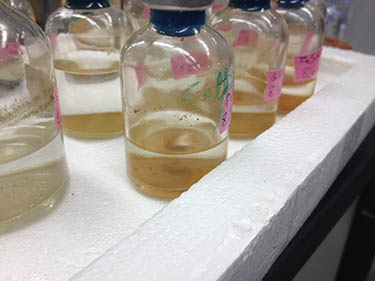A Tranquil Setting For An Extreme Organism

But in reality, this is a description of the laboratory of Ken Nealson, the Wrigley chair in environmental studies and a professor of Earth sciences and biological sciences at the University of Southern California in Los Angeles. His laboratory fills the entire fifth floor of Stauffer Hall and overlooks the middle of campus.
The microbes Nealson and his team study in this tranquil lab, however, prefer a much more inhospitable environment. They are extremophiles—organisms that love conditions humans would find intolerable, such as high pressure, high temperature or highly acidic areas of the world.
SEE ALSO: Meet the electric life forms that live on pure energy
Lina Bird leads a group of graduate journalism students around the lab in lieu of a tour by Nealson himself. His presence was still palpable, though, in the 8.5"x11" paper printouts depicting him standing in a mucky field. They were plastered throughout the lab with alternating captions of “I’m watching you” and “Get your ass to work.”
Bird, a post-doctoral researcher in Nealson’s lab, didn’t appear to need the motivation of her mentor’s stand-ins. She described the area of northern California called the Cedars where her microscopic subjects originate with as much enthusiasm for the extreme environment as for the bacteria themselves.
“This place is absolutely awesome,” Bird said. “It’s way back in the mountains. You drive back there and see that all of the dirt is actually this red color from all of the iron in the dirt. And you go over to the stream, and it looks like a perfectly healthy normal stream and then you come to these spots that are white, they look like they’ve been whitewashed.”
In a sense they have been whitewashed. The Cedars, located in Sonoma county, are home to highly alkaline, or basic, springs with a pH of 12—about the same level as ammonia. The result of this high pH, Bird said, is the consumption of protons and production of hydrogen. The springs can also be rich in methane and calcium. When the water reaches the surface, the calcium reacts with the highly alkaline water to create calcium carbonate, a compound commonly found in limestone and in-turn produces the whitewashed effect.
In addition to not minding the high pH, the bacteria also thrive in the anaerobic, or oxygen-less, conditions found deep underground where the springs originate.
READ MORE: Kenneth Nealson's discovery defy long-held assumptions
One of Birds’ projects is trying to figure out how organisms can survive in extreme environments. In order to do that, though, she has to study them under the conditions preferred by the observed, not the pleasant ones the laboratory provides for their human observers.
Several large, clear boxes sitting in the entry way to the lab make that possible. The boxes look like props for a movie about a disease outbreak, where the protagonist’s face would be visible from all angles while she or he fidgets with vials of a contagion. But the purpose of these containers, in addition to providing a sterile workspace, is to actually remove oxygen from the internal environment to make it possible for the organisms to survive outside of the springs.
Bird demonstrated how one of the machines works. The cuff of a plastic sleeve slips over the hand and wrist and up to mid forearm and slowly the air is sucked out of the sleeve. The sensation is similar to wearing a blood pressure cuff over the entire lower arm and the purpose is to remove all the air from the sleeve. At that point, two gates in the glass can be opened and the arms slipped through to work with the anaerobic bacteria on the other side.
Another thing that makes studying these organisms difficult is how tiny they are.
“They’re really small compared to what a normal bacteria might look like,” Bird said. “They don’t have all the DNA you’d expect. And one of the questions is—you have these things really deep underground. Have they been around a really long time? Have they been somewhat sheltered from all of the stuff that has happened on Earth through the geological time scales? Have they been down there since the time of early life, or have they somehow gone down there and adapted to this environment?”
Researchers know so little about these bacteria, Bird said, that they haven’t even classified them yet, instead relegating them to a grouping called candidate phyla. “Candidate phyla” essentially means researchers have seen the DNA sequences and have decided that they’re so different from anything they’ve seen before that “all we can say is that we know they exist.”
Why bother trying to understand these bacteria, though, if finding, classifying and working with them is so difficult?
The bacteria and their hostile environment are a good analogue for possible conditions for life on other planets, Bird said. Some of Nealson’s previous research with NASA’s Jet Propulsion Laboratory in Pasadena, Cal., explored the possibilities for life on other planets and the best way to detect it.
On a more practical note, Bird added, highly alkaline environments have become widely used in industrial applications, such as in the degradation of cellulose for potential use as a biofuel. Organisms such as those found in the springs at the Cedars could eventually be used in that process, once scientists understand more about them.
“One of the problems is that we don’t know enough, and this is something that scientists are always feeling or always realizing,” Bird said. “You have to keep pushing the boundaries of what we understand.”
Reach Contributor Jeanette Kazmierczak here.



